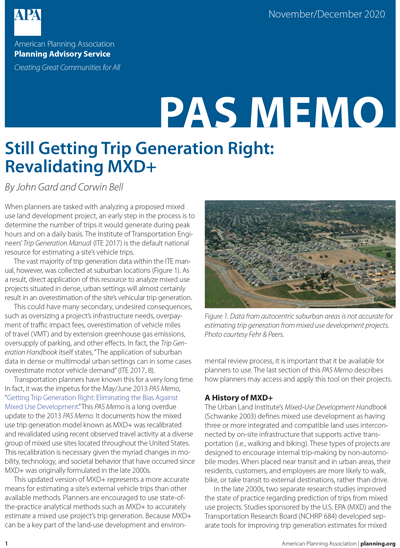Still Getting Trip Generation Right: Revalidating MXD+
PAS Memo — November-December 2020
By John Gard, Corwin Bell, AICP

When planners are tasked with analyzing a proposed mixed use land development project, an early step in the process is to determine the number of trips it would generate during peak hours and on a daily basis.
The Institute of Transportation Engineers' Trip Generation Manual is the default national resource for estimating a site's vehicle trips, but the vast majority of the trip generation data within the ITE manual was collected at suburban locations. Using it to analyze mixed use projects situated in dense, urban settings typically results in an overestimation of the site's vehicular trip generation. The potential consequences include oversizing a project's infrastructure needs, overpayment of traffic impact fees, overestimation of vehicle miles of travel (VMT) and greenhouse gas emissions, and oversupply of parking. It is important that planners use more accurate models to better estimate a mixed use project's trip generation.
This PAS Memo recalibrates and revalidates the mixed use trip generation model known as MXD+, which was presented in the May/June 2013 PAS Memo, "Getting Trip Generation Right: Eliminating the Bias Against Mixed Use Development," and describes how planners may access and apply this tool on their own projects.
Details
About the Authors
John Gard
John Gard, TE, is a principal with 25 years of consulting experience at Fehr & Peers. He has a bachelor’s degree in applied mathematics and a master’s degree in civil engineering from University of California–Davis.
Corwin Bell, AICP
Corwin Bell is a transportation planner at Fehr & Peers with a background in consulting and academic research. He earned a bachelor’s degree in urban studies and a master’s degree in city planning from University of California–Berkeley.


